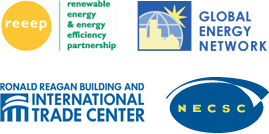|


POWERING A GLOBAL NAVAL FORCE
Cutting Energy Costs Through Innovation for the 21st Century
Keynote address by the Honorable Ray Mabus
Secretary of the Navy
Tom thank you, and thank you all for being here on this very wet morning. Tom and I were talking beforehand it seems as though when it starts drizzling, Washington traffic almost comes to a standstill. I’m happy to be here to speak about energy. I’m going to talk to you about our Navy and Marine Corps. They are today, globally deployed, globally engaged, the range of operations they are undertaking today and the scope of those operations and the geographic distribution of our fleet shows how important a continued strong Navy and strong Marine Corps are to the security and the safety of this country.
Since World War II, the United States Navy has been the ultimate guarantor of freedom of the seas, and unique in our history, unique in history of the world really, for the first time we have guaranteed the freedom of the seas for everyone, and not just our own ships. We have guaranteed equal access for the entire world. And whenever and wherever that freedom has been threatened, we have responded.
Even though, again Tom and I were talking before about how communications are changing, about how technologies are changing, even today more than 90% of all the trade for the world, not just the United States, goes by the sea, more than 95% of all telecommunications goes under the sea. And it’s for those reasons, among many others, that the Navy is globally deployed, that the Navy is globally engaged. Our maritime forces are incredibly flexible, extremely responsible, provides the leadership of this country with an array of options when a crisis arises. The Navy and Marine Corps are the most formidable expeditionary fighting force the world has ever known, because we can go where we are needed, we get there fast, we can win whatever fight there is when we get there and we don’t need to take up one square inch of anybody’s soil to do it. But what we do need, for all our operations, is energy. Fuel.
DoD is the largest energy consumer in the United States. We consume 90 percent of all the fossil fuel the federal government consumes and that’s two percent of all the fossil fuel that America uses. When you’re a military force, one of the things you do is you look at the vulnerabilities of potential adversaries, but you also at the same time ought to look at the vulnerabilities that you have. And fuel is right at the top of the list of the vulnerabilities that the American military has.
There is nothing new about this. There is nothing new about energy-related risks. I finished a book not long ago, guy named James Hornfischer wrote a book called Neptune’s Inferno. It’s about the Navy off Guadalcanal in WWII. In WWII when we were waging a war at sea with Japan his quote was: “ships were more powerful than they had ever been before, but were effectively tethered to bases by their insatiable need for fuel.”
Seeking out some viable energy options isn’t a fad; it isn’t the flavor of the day. It isn’t something we’re doing because it would be nice to do. It isn’t something we’re doing because it’s the hip thing to do or the cool thing to, or whatever my daughters’ words are that are in college today that I’m woefully behind on. It is… We’re doing it because we have to do it to be a more effective fighting force. The reasons are strategic, the reasons are tactical and the reasons are essential to our national security.
Changing the way we use and produce energy is fundamentally about improving security. From a strategic perspective, too much of the energy supplies for the American military come from either potentially or actually volatile places on Earth. Now, we would never allow these countries to build our ships or our aircraft or our ground vehicles, but we give them a vote on whether those ground vehicles operate, those ships sail or whether those planes fly because we get our fuel from them.
And even if we have the supply, you’ve got huge price risk. In October of 2009, when I first announced the energy goals for the Navy, the price of a barrel of oil was $76. Now that price has fluctuated since then from a low of $71 up to a high of $117, down to the current price of $105 that we’re paying, in the military, for a barrel of oil. Every $1 increase, $1 increase in the price of a barrel of oil costs the United States Navy $31 million in additional fuel cost. And so this range, this $71 to $117, that’s a $1.1 B range in budgeting uncertainty. And in this, or really in any budget climate but particularly in this one, that’s just an unacceptable level of uncertainty. We in the Defense Department are looking everywhere to find ways to save money while maintaining the strongest military in the world.
These unplanned price spikes, Libya as an example, a barrel of oil during Libya went up over $30. Now Libya is not a major supplier of ours, but it is a worldwide commodity. Just a hint of trouble causes these spikes. And the only place we have to go to get this extra money is out of our readiness accounts. That means fewer flying hours, means less training and fewer steaming days. And even if the US were to develop all the fossil fuels that we need, our military needs, as I said it’s a worldwide commodity; the price is set on an international stage. We‘d still be subject to all these spikes in price that we are today.
And odds are, if you look at history, and I was in Saudi Arabia 15 years ago as ambassador, right after I left in 1997 the price of a barrel of oil was $18 dollars. In 2000 it was $23, in 2005 it was $50, 2008 it was $96 and the annual average this year is running about $107 a barrel. Now, the odds are pretty high that this trend is not going to change. That the price is going to continue, with some dips, but over time to go up.
Avoiding particularly these price spikes, is one of the reasons, certainly not the only one, but one of them, we are developing some alternative fuels. It is critical for us to maintain and train and equip the combat-ready forces we are going to need to do the things we do: deter aggression, maintain freedom of the seas, and win when we have to. And the only reason, the only reason I am making this such a priority for the Navy and the Marine Corps is it makes us a better military force. It makes us better warfighters. Now there are some side effects and they are good side effects, but they are not the main reason we are doing it.
We can develop alternative fuels and I’ll talk just for a minute about the biofuel market. We can use a domestic, renewable feedstock that’s stable, has price stability, it’s going to take us a long way toward smoothing out some of these price spikes. Now we’ve been doing a whole lot of outreach to the industry and the venture capital and private equity communities, and what’s become clear is that somebody’s got to bridge the so called “valley of death” from R&D, which there’s a lot of R&D being done right now, a lot of big brains working on this, to production, affordable, competitive, volume production; that’s the barrier, getting from the good idea in the lab and small test batches to commercially viable fuels. We almost have to do this. And we have to do it in a way that will work in existing engines, we’re not going to change the engines that we’ve got in our ships or our planes or vehicles, and it’s got to work in a way that doesn’t harm the food supply, doesn’t take food off anybody’s table.
Those are the strategic reasons. The tactical reasons are, if anything, more compelling. If I look a little tired, it’s because I am. We took a five day trip, got back a few days ago, five countries, five days. And Afghanistan was the main focus of the trip. This was my sixth trip to Afghanistan, and I go there to see our Marines. I go there to see what the Marines, the 20,000 Marines in Helmund river valley in southern Afghanistan are doing. How they’re doing, what their concerns are, how the security situation is. But if you’ll think with me just for a minute; to get a gallon of gas to those forward operating bases in Afghanistan, gasoline and water are the two things we import the most into Afghanistan, to get it there you have to take it across one ocean or the other, the Pacific or the Atlantic. Then you’ve got to put it on trucks and either take it up to Afghanistan through Pakistan or down through the Northern Distribution Network. You’ve got to cross either the Hindu Kush mountain range or across the Amu Darya River, and then once in Afghanistan you’ve got to get it all the way to that Forward Operating Base to those Marines out there on the tip of the spear.
Now, it’s expensive, it’s expensive in a lot of ways. It costs a lot of money, but also for every 50 convoys we bring in, we lose a Marine, either killed or wounded. And that’s just way too high a price to pay for fuel.
A few months ago, Third Battalion, Fifth Marines, deployed in the middle of a very tough fight in Sangin Province. And in the middle of this fight, they cut their fossil fuel use and their logistical supply requirements by 25 percent at main operating bases and up to 90 percent at combat outposts by relying on alternative energy that they had been given in the US, sort of on their way out the door, to Afghanistan.
One three week patrol reduced their carry weight in batteries by 700 lbs by using roll-up solar supply sources to power their radios. They saved $40,000, but most importantly they didn’t have to get resupplied every two to three days. It makes us more truly expeditionary and it reduces some of the most dangerous missions that we have.
The most successful technologies that 3/5 took in to Afghanistan are now being deployed with Marine Battalions all across Afghanistan . And right now the cost -- and I know this is a Washington audience so I am saying million and not billion -- the cost is $25 million. It’s going to save $50 million per year, just in transport cost, so it pays for itself in six months. But more important, is one battalion taking these alternative energy devices in solar and wind, and being more efficient by using insulation, are saving 450 resupply flights that we don’t have to do and taking a total of 180 trucks off the road, and saving the lives of Marines.
So there are compelling, strategic and tactical reasons to switch the way we produce fuel. There are also the same reasons to switch the way we use it. We’ve got to be more efficient in the way we use fuels because more efficiencies mean the same thing: fewer trucks on the road; fewer Marines at risk.
The Navy is the most at-risk during refueling. That’s what the Cole was doing in Aden, Yemen in 2000 when it was attacked. If we can limit the number of times our ships or our expeditionary forces have to refuel, we can limit that vulnerability.
It affects our budget, it affects our strategic outlook. We just launched last year the first hybrid ship in the Navy, USS Makin Island. It’s a big ship, it’s a big deck amphibious ship. It was built in my home state of Mississippi, in Pascagoula. In its maiden voyage from Pascagoula, around South America to San Diego where it’s going to be homeported, it saved almost $2 million in fuel costs. It’s got an electric engine for speeds under 12 knots and a normal diesel for speeds of over 12 knots. Come to find out, most warships don’t go that fast, that often. It saved two million dollars in one voyage. Now at that gasoline price -- and it was way lower then than it is today -- when it was launched, that ship will save $250 million over its lifetime.
We’re putting a hybrid drive on USS Truxton, a DDG proof of concept. And if we are successful in doing that, we’re going to save about 8,500 barrels of fuel on that ship alone per year. And we’re looking at putting it on all our surface combatants.
We’re doing some other stuff, too. We’re looking at system wide energy performance when we set up requirements and also in the acquisition process. We are looking at that in addition to things like speed, or payload or range, so we can better manage the life-cycle costs of these things.
And the people who are doing a lot of this are the United States Marines. Now nobody has ever accused the United States Marines of being a soft organization, or if they have they have not been as healthy after doing it as they were before doing it. The Marines aren’t doing this because it’s faddish. The Marines aren’t doing this because it’s trendy. The Marines are doing this because it makes them better fighters. Because it frees them up to do what their job is, which is to fight or to engage or to rebuild, and it takes them away from some things that aren’t core to their mission, like guarding convoys.
I’ve had the question, why should the Navy be doing this? Why should the Navy and Marine Corps be doing this? Well, one of my answers is history. The Navy has been at the forefront of technological change on energy for 150 years.
In the 1850s we went from sail to coal, in the early part of the 20th century we moved from coal to oil, and then in the 1950s we pioneered the use of nuclear fuel in our warships. Innovation in the way we power our ships has been one of the core competencies of the United States Navy throughout its whole history.
Now, at every one of those transitions, every time, there were a whole lot of folks who said, this is nuts. You’re trading one form of absolutely known power for another that you don’t know, if it’s going to work or not.
Imagine in the 1850s, we were trading wind, which had been used for thousands of years, for coal. And a report came out from five Admirals in the United States Navy at that time that said: this will never work; we need to stick with wind. Look at all the problems you are going to have. You’re going to have to have people shoveling that coal, you’re going have to have coaling stations all around the world, stick with wind we know what we’re doing here. The same thing happened when we went to coal, I mean oil from coal. But now it was, wait a minute, we’ve got all these coaling stations around the world, why are you switching, why are you going to something else? And when we went to nuclear, iif you look back at those debates, [they said] it’s too unstable, it’s too unsafe, we’ll never be able to do it as small a reactor vehicle as you need to, particularly to put it on submarines. It is too unpredictable. Don’t do it. It won’t work.
All those things I’ve mentioned have worked spectacularly well. And the work we are doing today, to change the way we use and produce fuel, is working too.
We have flown the F/A-18 Hornet, on biofuels, the Green Hornet. It went 1.7 mach, 1.7 times the speed of sound, the airplane did not notice the difference. We have now tested and certified virtually all our aircraft, helicopters, the V-22 tilt rotor for the Marines, things like the EA-6B Prowler, our trainers, the harriers, we’ve done it on our Riverine patrol craft and we are on the way, by the end of this Fall to have every single aircraft that we operate, and we operate a lot of aircraft, more than 3500 in the Navy and Marine Corps. All of them will be certified for use on a mixture of biofuel and regular fuel. And by the end of next year, all our surface combatants will too.
And its, I’ve been talking about biofuels, but it sure isn’t just about biofuels. We’re a seagoing service, we’re a maritime service, but we also have 3.3 million acres of land 72,500 buildings. We’re doing solar and wind, we’re doing geothermal and hydrothermal, we’re doing wave. One of our bases, China Lake in California, is now net positive to the grid. We’re giving more energy back to the grid than we are pulling off the grid from hydrothermal sources. And by 2020 at least half our bases, at least half, are going to be net zero to the grid. We’ve got, right now, on the drawing board, enough alternative energy that’s going to be put in our bases to power a city the size of Norfolk, VA.
And the pay back, you’re looking for savings in these days, the pay back is pretty fast. Now the payback in terms of lives and military efficiencies is instant, but the payback in the terms of money is mostly…. We operate at the Pentagon on a five year budget cycle, the FYDP. Future Years Defense Program. In fact one of my big challenges is remember what year I am actually in. Right now we are in calendar year 11, right? Next week, we’re going to be in fiscal year 12. We are deep into preparations for the budget for fiscal year 13 and the budget preparations for 13 is 13 through 17.
But, most of these energy sources, the payback is within that FYDP or very close to it. And then the savings just keep on multiplying, from then on out. So if you’re looking for efficiencies if you are looking to save money in this budget environment, this is one of the ways to do it. If you, if you read some of the books that are out there like Tipping Point or Chaos Theory, the notion is that systems tend to stay pretty static, that they tend to keep doing exactly what they are doing until all of a sudden they change, just about overnight.
When I went to Saudi Arabia as ambassador in 1994, when I left, nobody had a cell phone. I mean nobody. And the Internet was about as primitive, remember those green screens and it would take you forever to log on or to get any sort of information and there was no graphics, it was just words. By the time I came back from Saudi Arabia two years later, everybody had a cell phone, everybody. And the Internet was far more powerful. We see it almost in real time today with smart phones and the way we get information. That was, those were systems that had stayed the same for a long, long period that suddenly changed.
And I think that we are getting to that point on fuel. That doesn’t mean that fossil fuels are going to go away, it doesn’t mean that fossil fuels won’t have a seat at the table, because they will. It’s just that they’re not going to have the only seat at the table.
And I think the military can, and should, lead the way in developing new options. For the past 235 years, the United States Navy and the United States Marine Corps have been leaders, have been innovators in energy.
By changing the way we use energy, by changing the types of energy we use, by changing the way we produce it, we’re going to continue to have the most formidable expeditionary fighting force this world has ever known. And the Navy and the Marine Corps are going to continue to do what they have always done: innovate, adapt and come out on the other side victorious.
My favorite Navy recruiting poster, the tag line is; “Sometimes we follow the storm to the shore, sometimes we are the storm.”
Thank you very much
|
 |
 |

 SPECIAL REPORT SPECIAL REPORT |
|

 LATEST DEVELOPMENTS LATEST DEVELOPMENTS |
|

 ORGANIZATIONAL PARTNERS ORGANIZATIONAL PARTNERS |






 |

 MEDIA PARTNERS MEDIA PARTNERS |


 |

 FOLLOW US ON THE WEB FOLLOW US ON THE WEB |

|
|


